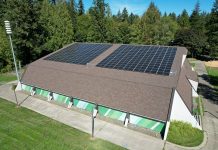Jack Klotz has been a rocketeer from boyhood. Since his dad came to his science class to demonstrate model rockets, it became an enduring passion. When Jack came to Packwood a couple years ago, he left behind his beloved rocketry club in Henderson, Nevada. Parting with them was very difficult.
Fortunately, Packwood’s open spaces make superb rocket launch sites. Jack could launch rockets alone. But that’s hardly the same fun as sharing the interest with others. So, he’s looking for aspiring rocketeers to join the Washington State Model Rocket Club, an exciting new endeavor. Meetings occur weekly at the Packwood library, during the launch season from spring to fall. See the website for meeting times.

When the rocket club held its first meeting, Jack brought rockets in several sizes, along with equipment to launch them and information on getting started. Basic safety instruction and elementary rocket science must precede launching, after all. The rules for rocketeers keeps rocketry safe. Elementary rocket science ensures the rockets launch correctly and fly their optimum path. The club teaches these principles.
The club has permits to launch at the Packwood baseball field at the end of Silver Road, on the way to Skate Creek. Permits to launch at the closed lumber mill are in the works. With so much open space in Packwood, the club will likely obtain other sites.
Model rocketry is suitable for everyone age 10 to adult. A rocket kit is the easiest way to get started. Inexpensive kits come from vendors such as Estes. These kits come in various skill levels for rocket construction.
Jack explained that larger rockets use larger engines to give greater thrust and support the payload. Rocket engines get letter grades rating the thrust and resulting altitude the rocket can reach. Commonly sold engines come in grades A to G, in increasing order of thrust and altitude. You reuse your rocket by inserting a new engine. Rocketeers usually purchase engines rather than reload them, as the materials involve black powder. Fortunately, Packwood’s rocket club will have donated engines.
User Beware

Jack showed his blast plate, which protects the launch equipment and prevents the ground surface from catching fire. Scorched and oxidized, his blast plate is a veteran of many launches.
An ignitor fires the rocket from a safe distance. The safest ignitors use a dead man switch with a key that one must hold down with one hand while pressing the firing button with the other. Using ignitors without a dead man key is dangerous. People have carelessly pressed the firing button while still holding the rocket engine in their other hand, resulting in significant burns.
Malfunctioning rockets can follow two especially dangerous paths. A whistle dive occurs when the parachute fails to eject and the open nose cone allows air to enter the rocket chamber. This results in the characteristic whistle on decent. Referring to a rocket he recently rebuilt after one such mishap, Jack said, “I had this one go literally five feet into the ground.”

A death dive is even scarier. It occurs with the more powerful engines, such as the F and G types. “It goes haywire either because the parachute doesn’t deploy or the parachute catches fire,” Jack said. “They sometimes occur at 3,800 feet – that’s a scary altitude.”
The rocket explodes under the pressure of the descent and the pieces become shrapnel.
When asked about interference with aircraft, Jack confirmed that’s a concern. Packwood has a fairly active small airport. The FAA requires model rockets to not present a hazard to aircraft; high power rockets require an FAA permit. “There’s a certain code that you go by when you shoot off model rockets,” Jack explained.
The National Association of Rocketry maintains the code. They also certify rocket clubs, allowing then to compete, take money, and win trophies. Several rocket clubs thrive in Puget Sound. In time, the Packwood club might compete as well.
Three … Two … One … Launch!

Many rockets will launch on designated launch days, so club members take on different roles at the launch area. A launch control officer monitors who is firing the rocket on the launch pad. A launch safety officer monitors the entire launch area to ensure people are in safe positions. Trackers observe the rocket in flight and warn if the rocket takes a dangerous path. A recovery team recovers landed rockets.
There is more to do with rockets than only launching and watching them ascend and return to earth.

Camera rockets show the view down from a rocket in flight. It’s a dizzying thrill ride to watch the movies and imagine yourself as a passenger. When the rocket turns over at apogee, the view really makes your stomach turn. “Camera rockets are cool,” Jack said.
Rocket mail delivers messages by rocket. When the ejection charge ignites, a packet containing the message escapes the rocket and floats back to the ground, driven by the wind. It’s a special kind of airmail. An orange flag attached to the message makes it easy to find. Anyone finding the rocket mail is encouraged to reply to the sender who launched the rocket, and join the rocket club.
Model rockets put rocket science in the hands of everyone and can lead to rocketry careers. Twenty-first-century rocket companies like SpaceX and Blue Origin are leading a new era of private enterprises. They’re building rockets to go into space, once a role reserved for governments. A goal for these companies is to eventually offer safe space flight to private citizens. Model rocketeers will surely feed this revolution. Now you can help rocketry find a new home in Packwood.












































